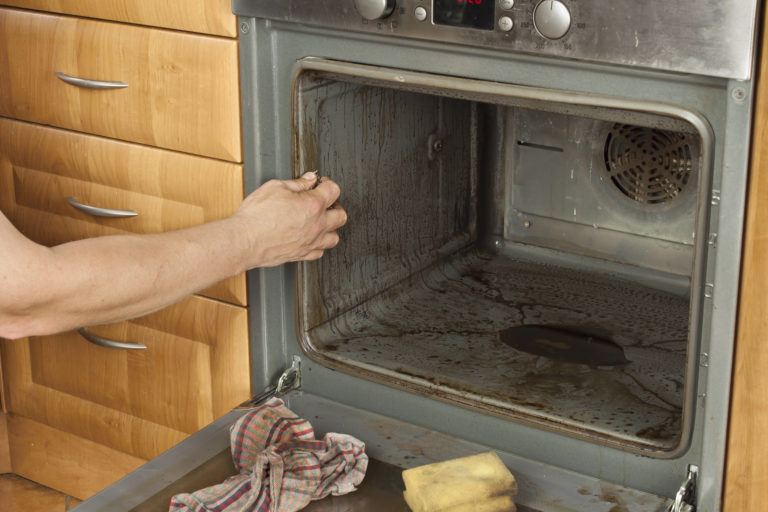
Quick Tips
- Start by removing the oven racks and soaking them in warm, soapy water.
- Use baking soda, water, and liquid dish soap for natural oven cleaning.
- Scrub all the interior surfaces of the oven with a sponge or soft-bristled brush to eliminate crusty or discolored spots.
- After you finish scrubbing, rinse away the leftover residue of baking soda and oven gunk.
- Clean the oven racks.
- Clean the outer surfaces of the oven.
Before I say anything else, I should probably admit that cleaning the oven usually falls strictly into the category of Things I Do Before Moving Out of an Apartment So We Get the Damage Deposit Back. I hate it so much that I have been known to ignore a greasy mound of charcoal at the bottom of an oven for literally years on end. And it’s not just the hour of awkward, stand-on-your-head-and-reach-across-the-oven-door, super-intense scrubbing that I hate. It’s also the oven cleaner fumes. Maybe it’s even mostly the fumes. Even with the kitchen fan on and every window in the place open, I need to take breaks from scrubbing just so I can go outside to gulp fresh air, cough out the toxins, and swig water to soothe my burning nose, throat, and lungs.
Oven cleaning products are specially qualified to produce reactions like this because they rely on a cocktail of corrosive chemicals to cut through grease and cooked-on grime. Most contain sodium hydroxide, a.k.a. lye, which, if you watch anywhere near as much CSI as I do, you know can be used to dissolve all the tissue off a human body if necessary. In the form of oven cleaner fumes, it usually limits itself to irritating the eyes, skin, and respiratory system. Butane, which works both to propel the cleaner from the aerosol can and to help dissolve the carbon component of oven gunk, is so common that it’s even listed as the first ingredient in at least one supposedly “green” oven cleaner—never mind that it can cause brain damage with repeated exposure. Since these are just two of many nasty chemicals lurking in a normal can of Toxic Oven Cleaner, I decided to try a less caustic approach this time. Given how much scrubbing is involved in cleaning an oven even with chemical foam, I admit I had my doubts at first. But now? I’ll never again use anything but the following method.
How to Clean an Oven Naturally
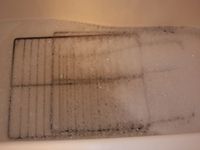 Start by removing the oven racks and soaking them in warm, soapy water. To do this, you’ll need to fill a large sink or tub with warm water a couple of inches deep. Squirt in a little bit of eco-friendly liquid dish soap—I used the stuff made by Seventh Generation—as the water runs, so that you get a slightly sudsy solution. Remove the metal racks from the oven and transfer them directly into the tub of soapy water. Let them soak while you clean the inside of the oven; the longer they’re in the water, the easier they’ll be to scrub down later.
Start by removing the oven racks and soaking them in warm, soapy water. To do this, you’ll need to fill a large sink or tub with warm water a couple of inches deep. Squirt in a little bit of eco-friendly liquid dish soap—I used the stuff made by Seventh Generation—as the water runs, so that you get a slightly sudsy solution. Remove the metal racks from the oven and transfer them directly into the tub of soapy water. Let them soak while you clean the inside of the oven; the longer they’re in the water, the easier they’ll be to scrub down later.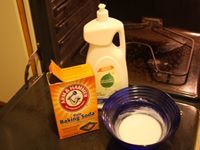 Use baking soda, water, and liquid dish soap for natural oven cleaning. You want to combine the three ingredients into a paste that’s thick enough to stick to the top and sides of the oven. I usually pour some baking soda into a bowl, add a few drops of Seventh Generation dish soap, and then drizzle a little water on top. After stirring it all together, I evaluate the consistency and add more water or baking soda as needed. Since the dish soap is just there to help cut grease, you don’t need much of it. Once the mixture is prepared, brush any loose chunks out of the bottom of the oven, then use a sponge to “paint” a layer of baking soda paste onto all the interior surfaces of the oven, including the door. Let sit at room temperature for at least 10 minutes.
Use baking soda, water, and liquid dish soap for natural oven cleaning. You want to combine the three ingredients into a paste that’s thick enough to stick to the top and sides of the oven. I usually pour some baking soda into a bowl, add a few drops of Seventh Generation dish soap, and then drizzle a little water on top. After stirring it all together, I evaluate the consistency and add more water or baking soda as needed. Since the dish soap is just there to help cut grease, you don’t need much of it. Once the mixture is prepared, brush any loose chunks out of the bottom of the oven, then use a sponge to “paint” a layer of baking soda paste onto all the interior surfaces of the oven, including the door. Let sit at room temperature for at least 10 minutes.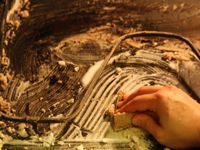 Scrub all the interior surfaces of the oven with a sponge or soft-bristled brush to eliminate crusty or discolored spots. I recommend starting with the inside of the door so that you aren’t leaning into a layer of homemade baking soda oven cleaner during the rest of the process, then scrubbing the top of the oven, followed by the sides and finally the bottom. I used a Scotch-Brite Greener Clean sponge made partly with natural and recycled fibers, and even though baking soda is itself mildly abrasive, it was helpful that one side of the sponge was a scrubbing pad. I had let a pan of bacon-topped meatloaf cook over a while back, and found that a plastic pan scraper was the best tool for lifting the really thick deposits on the bottom of the oven.
Scrub all the interior surfaces of the oven with a sponge or soft-bristled brush to eliminate crusty or discolored spots. I recommend starting with the inside of the door so that you aren’t leaning into a layer of homemade baking soda oven cleaner during the rest of the process, then scrubbing the top of the oven, followed by the sides and finally the bottom. I used a Scotch-Brite Greener Clean sponge made partly with natural and recycled fibers, and even though baking soda is itself mildly abrasive, it was helpful that one side of the sponge was a scrubbing pad. I had let a pan of bacon-topped meatloaf cook over a while back, and found that a plastic pan scraper was the best tool for lifting the really thick deposits on the bottom of the oven.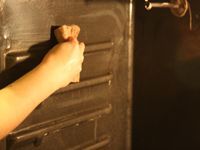 After you finish scrubbing, rinse away the leftover residue of baking soda and oven gunk. One of the advantages when you clean your oven this way is that most of the “rinsing” can be accomplished without any moisture. Because the baking soda paste will have dried by this point, you can wipe most of it off with a dry cloth and then use the same cloth to sweep the dust and chunks out of the bottom of the oven onto a layer of old newspaper on the floor. If there’s still a thin layer of baking soda dust inside the oven afterward, you can wipe it away with a cloth dampened in tap water.
After you finish scrubbing, rinse away the leftover residue of baking soda and oven gunk. One of the advantages when you clean your oven this way is that most of the “rinsing” can be accomplished without any moisture. Because the baking soda paste will have dried by this point, you can wipe most of it off with a dry cloth and then use the same cloth to sweep the dust and chunks out of the bottom of the oven onto a layer of old newspaper on the floor. If there’s still a thin layer of baking soda dust inside the oven afterward, you can wipe it away with a cloth dampened in tap water.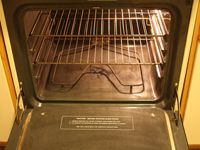 Clean the oven racks. Since they’ve been soaking in soapy water for a while, you should be able to remove most of the baked-on food from the oven shelves with a wet rag or dishcloth, but you could use a scrub brush or scrubbing pad for more oomph. I don’t mind if my oven racks are a bit discolored, but if you want yours shiny again, more baking soda paste should do the trick. Once the shelves are clean, rinse them in some fresh water and either let them air dry or wipe them down with a dry rag before replacing them in your clean oven.
Clean the oven racks. Since they’ve been soaking in soapy water for a while, you should be able to remove most of the baked-on food from the oven shelves with a wet rag or dishcloth, but you could use a scrub brush or scrubbing pad for more oomph. I don’t mind if my oven racks are a bit discolored, but if you want yours shiny again, more baking soda paste should do the trick. Once the shelves are clean, rinse them in some fresh water and either let them air dry or wipe them down with a dry rag before replacing them in your clean oven.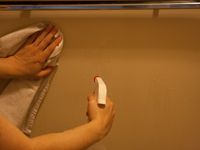 Clean the outer surfaces of the oven. Whether you have a stainless steel or enamel-coated oven, you can clean the door and other outer surfaces with vinegar. Simply pour some undiluted white vinegar into a spray bottle, spray the vinegar onto a soft cotton cloth, and wipe to remove grease, splattered food, and fingerprints. Vinegar can also be used for cleaning oven glass, both on the inside and outside of the door, though you may prefer to clean the inside of the window with the baking soda paste used for the rest of the oven cavity. Now, if you’re feeling inspired, you already have everything you need for Jonathan’s method of cleaning a stove.
Clean the outer surfaces of the oven. Whether you have a stainless steel or enamel-coated oven, you can clean the door and other outer surfaces with vinegar. Simply pour some undiluted white vinegar into a spray bottle, spray the vinegar onto a soft cotton cloth, and wipe to remove grease, splattered food, and fingerprints. Vinegar can also be used for cleaning oven glass, both on the inside and outside of the door, though you may prefer to clean the inside of the window with the baking soda paste used for the rest of the oven cavity. Now, if you’re feeling inspired, you already have everything you need for Jonathan’s method of cleaning a stove.
Self-Cleaning Ovens
Unfortunately, the laws of physics limit the extent to which self-cleaning ovens can actually clean themselves. What a self-cleaning oven can do is prepare itself for cleaning in a way that makes your role in the process a lot easier to stomach. During the “clean” cycle, an oven’s internal temperature reaches 900 degrees Fahrenheit, which is hot enough to turn the gunk stuck inside to ash over the course of a few hours. Once the cleaning cycle is over and the oven has had a chance to cool, all that’s left for you to do is wipe away the ashy residue with a rag or damp sponge.
Besides being easier to clean, self-cleaning ovens have the added advantage of being very well-insulated and therefore more energy efficient during regular use. However, the cleaning cycle itself requires a lot of energy, which could offset the energy savings if you run it often. If you don’t run it often and the oven gets very dirty, you’ll either have to clean it by hand (without aerosol oven cleaners, which aren’t generally recommended by self-cleaning oven manufacturers because of concerns about toxic residues and very high temperatures) or endure some smoke while the larger spills are burned off. Which, all things considered, may be better than the oven cleaner fumes.
Continuous-cleaning ovens work thanks to a special rough coating on their internal surfaces that spreads spills and splatters out into a thinner layer that can be burned away at regular cooking temperatures. Larger spills should be wiped up with a damp sponge before they have a chance to bake on and compromise the surface texture.
Non Toxic Oven Cleaners
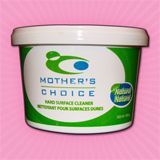 Mother’s Choice is an all-purpose cleaner that was originally concocted with oven cleaning in mind. Organic, biodegradable, and completely non-toxic, it derives its cleaning power from natural enzymes and finely ground pumice.
Mother’s Choice is an all-purpose cleaner that was originally concocted with oven cleaning in mind. Organic, biodegradable, and completely non-toxic, it derives its cleaning power from natural enzymes and finely ground pumice.
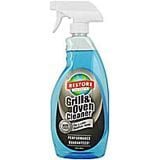 Restore Grill & Oven Cleaner is a non-caustic, non-toxic cleaner and degreaser made with plant- and mineral-based ingredients. I especially like this company because it was founded in my home state of Minnesota, and my local natural foods store has a station for refilling empty bottles of Restore products. You can order Restore Oven Cleaner from Amazon.
Restore Grill & Oven Cleaner is a non-caustic, non-toxic cleaner and degreaser made with plant- and mineral-based ingredients. I especially like this company because it was founded in my home state of Minnesota, and my local natural foods store has a station for refilling empty bottles of Restore products. You can order Restore Oven Cleaner from Amazon.
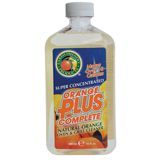 Orange Plus Complete Natural Orange Oven & Grill Cleaner, made by Earth Friendly Products, is a concentrated all-purpose cleaner made with orange oil and other biodegradable ingredients. Like Restore Grill & Oven Cleaner (above), Orange Plus Complete is not tested on animals.
Orange Plus Complete Natural Orange Oven & Grill Cleaner, made by Earth Friendly Products, is a concentrated all-purpose cleaner made with orange oil and other biodegradable ingredients. Like Restore Grill & Oven Cleaner (above), Orange Plus Complete is not tested on animals.